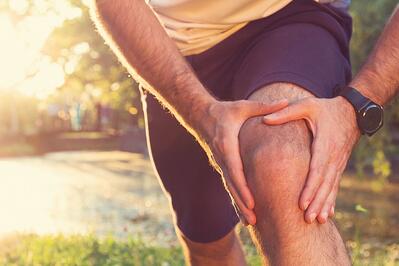Sports and exercise are healthy activities for people of all ages. Recently, there has been an increasing trend for more active lifestyles through a wide variety of exercise programs and sporting activities. However, this increased involvement does carry the risk of injury. The most common sports injuries sideline millions of people each year, and this number is expected to rise along with the number of participants.
The term “sports injuries” refers to the types of injuries that occur during sports or exercise. Some result from accidents, while others are due to those that overdo or who don’t properly train or warm up. Fortunately, most sports injuries can be treated effectively with return to the preinjury level of activity. Additionally, many can be prevented if people take the appropriate precautions.
1. Neck Strain (Whiplash)
- Definition: Injury to the muscles of the neck, which are stretched or torn
- Cause: Neck is suddenly whipped or forced backwards or forwards
- Symptoms: Pain, stiffness and muscle spasms in the neck
- At Risk Sports: Football, rugby, wrestling, hockey, cheerleading, gymnastics, diving
2. Rotator Cuff Disease
- Definition: Inflammation of the tendons (tendinitis) surrounding the shoulder
- Cause: Repetitive, overhead activities (throwing, weight lifting, overhead work)
- Symptoms: Shoulder pain aggravated with reaching overhead or lifting
- At Risk Sports: Tennis, swimming, weightlifting, baseball, volleyball
3. Golfer’s and Tennis Elbow
- Definition: Inflammation to the inside (golfer’s) or outside (tennis) of the elbow
- Cause: Chronic, repetitive stress to the muscles and tendons of the forearm
- Symptoms: Pain to the inside or outside of the elbow, especially with gripping and twisting motion of the wrist
- At Risk Sports: Baseball, tennis, golf, bowling
4. Low Back Pain
- Definition: Injury to the muscles, tendons or ligament of the lower back
- Cause: Twisting awkwardly, lifting a heavy weight or doing some unpracticed activity
- Symptoms: Pain, stiffness and muscle spasms to the lower back
- At Risk Sports: Weightlifting, golf, martial arts, tennis, gymnastics
5. Muscle Pulls
- Definition: Stretched or torn muscle, typically involving thigh or calf muscles
- Cause: Sudden overload on a tight muscle during running, jumping or lifting
- Symptoms: Pain, muscle spasms, swelling and trouble moving the muscles
- At Risk Sports: All sports
6. Runner’s Knee
- Definition: Inflammation and pain at the patellar tendon, just below the kneecap
- Cause: Sudden increase or repetitive overuse of the quadriceps and patellar tendon
- Symptoms: Pain and tenderness to the kneecap or below, especially with activity
- At Risk Sports: Running sports; sports with jumping, quick starts or kicking
7. Knee Sprain
- Definition: Stretch or tear of a knee ligament, which connects the thigh and leg bone
- Cause: Direct blow, twisting injury or fall on to the knee
- Symptoms: Pain, tenderness and swelling to the knee; limping or difficulty bearing weight
- At Risk Sports: Football, rugby, basketball, soccer
8. Shin Splints
- Definition: Pain in the lower leg due to exercise or athletic activity
- Cause: Overuse from repetitive activity
- Symptoms: Pain along the inner and lower half of the shin, mostly with activity
- At Risk Sports: Endurance running, soccer, walking, jogging
- Definition: Stretch or tear of the ligaments of the ankle
- Cause: Sudden twist or rolling injury to the foot
- Symptoms: Pain, tenderness and swelling to the ankle; limping or difficulty bearing weight
- At Risk Sports: Trail running, basketball, football, tennis, soccer, volleyball
10. Achilles Tendinitis
- Definition: Inflammation and pain along the back of the ankle
- Cause: Sudden increase or repetitive overuse of the lower leg muscles and Achilles tendon
- Symptoms: Pain and tenderness over Achilles tendon, especially with pushing off or pushing down with the front of the foot
- At Risk Sports: Running sports; sports with jumping, quick starts or kicking
The initial treatment for the most common sports injuries should follow the RICE method for the first 48 hours:
- R (Rest): stop using the injured area, using crutches if necessary
- I (Ice): application of ice will help to decrease pain and swelling
- C (Compression): maintaining pressure to the affected area will help limit swelling
- E (Elevation): elevation will help to limit the use of the injured body part, as well as decrease swelling.
Once the initial pain and swelling have subsided, a graduated rehabilitation program is recommended. Typically, this begins with gentle range‐of-motion exercises and progresses to a stretching and strengthening program as long as there is no increasing pain. Activity level will continue to progress until the athlete has returned to their preinjury level of activity.
Although the risk of injury cannot be eliminated, there are several preventative measures that can reduce the risk of injury. This begins with appropriately warming up and stretching before an exercise or sporting activity. Additionally, most injuries occur when people suddenly increase the duration, intensity or frequency of their activities. Thus, knowing one’s limits and slowly increasing the level of exercise gradually will help to decrease the amount of overuse injuries. At the end of a workout, the muscles should be cooled down by slowly decreasing the level of exercise and stretching rather than stopping abruptly. Finally, appropriate rest is needed in between workouts to allow the muscles to recover and be ready for their next activity.
Learn more about common baseball injuries, common volleyball injuries, and common football injuries.
For immediate treatment of athletic injuries, visit an ortho urgent care clinic.

